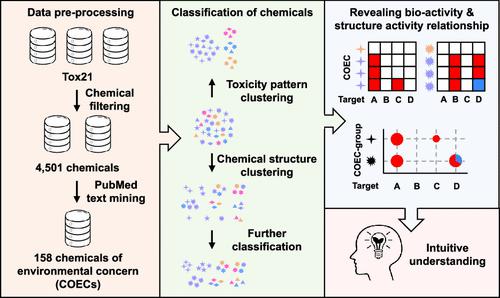当前位置:
X-MOL 学术
›
Environ. Sci. Technol.
›
论文详情
Our official English website, www.x-mol.net, welcomes your feedback! (Note: you will need to create a separate account there.)
Tox21-Based Comparative Analyses for the Identification of Potential Toxic Effects of Environmental Pollutants
Environmental Science & Technology ( IF 11.4 ) Pub Date : 2022-09-30 , DOI: 10.1021/acs.est.2c04467 Renjun Yang 1, 2 , Shuyu Liu 1, 2, 3 , Nuoya Yin 1, 2 , Yang Zhang 4 , Francesco Faiola 1, 2
Environmental Science & Technology ( IF 11.4 ) Pub Date : 2022-09-30 , DOI: 10.1021/acs.est.2c04467 Renjun Yang 1, 2 , Shuyu Liu 1, 2, 3 , Nuoya Yin 1, 2 , Yang Zhang 4 , Francesco Faiola 1, 2
Affiliation

|
Chemical pollution has become a prominent environmental problem. In recent years, quantitative high-throughput screening (qHTS) assays have been developed for the fast assessment of chemicals’ toxic effects. Toxicology in the 21st Century (Tox21) is a well-known and continuously developing qHTS project. Recent reports utilizing Tox21 data have mainly focused on setting up mathematical models for in vivo toxicity predictions, with less attention to intuitive qHTS data visualization. In this study, we attempted to reveal and summarize the toxic effects of environmental pollutants by analyzing and visualizing Tox21 qHTS data. Via PubMed text mining, toxicity/structure clustering, and manual classification, we detected a total of 158 chemicals of environmental concern (COECs) from the Tox21 library that we classified into 13 COEC groups based on structure and activity similarities. By visualizing these COEC groups’ bioactivities, we demonstrated that COECs frequently displayed androgen and progesterone antagonistic effects, xenobiotic receptor agonistic roles, and mitochondrial toxicity. We also revealed many other potential targets of the 13 COEC groups, which were not well illustrated yet, and that current Tox21 assays may not correctly classify known teratogens. In conclusion, we provide a feasible method to intuitively understand qHTS data.
中文翻译:

基于 Tox21 的比较分析,用于识别环境污染物的潜在毒性影响
化学污染已成为突出的环境问题。近年来,已开发出定量高通量筛选 (qHTS) 测定法,用于快速评估化学品的毒性作用。21 世纪毒理学 (Tox21) 是一个知名且不断发展的 qHTS 项目。最近使用 Tox21 数据的报告主要集中在为体内建立数学模型毒性预测,较少关注直观的 qHTS 数据可视化。在这项研究中,我们试图通过分析和可视化 Tox21 qHTS 数据来揭示和总结环境污染物的毒性作用。通过 PubMed 文本挖掘、毒性/结构聚类和手动分类,我们从 Tox21 库中检测到总共 158 种环境问题化学品 (COEC),我们根据结构和活性相似性将其分为 13 个 COEC 组。通过可视化这些 COEC 组的生物活性,我们证明了 COEC 经常表现出雄激素和孕酮拮抗作用、外源性受体激动作用和线粒体毒性。我们还透露了 13 个 COEC 小组的许多其他潜在目标,这些目标尚未得到很好的说明,并且当前的 Tox21 检测可能无法正确分类已知的致畸剂。总之,我们提供了一种可行的方法来直观地理解 qHTS 数据。
更新日期:2022-09-30
中文翻译:

基于 Tox21 的比较分析,用于识别环境污染物的潜在毒性影响
化学污染已成为突出的环境问题。近年来,已开发出定量高通量筛选 (qHTS) 测定法,用于快速评估化学品的毒性作用。21 世纪毒理学 (Tox21) 是一个知名且不断发展的 qHTS 项目。最近使用 Tox21 数据的报告主要集中在为体内建立数学模型毒性预测,较少关注直观的 qHTS 数据可视化。在这项研究中,我们试图通过分析和可视化 Tox21 qHTS 数据来揭示和总结环境污染物的毒性作用。通过 PubMed 文本挖掘、毒性/结构聚类和手动分类,我们从 Tox21 库中检测到总共 158 种环境问题化学品 (COEC),我们根据结构和活性相似性将其分为 13 个 COEC 组。通过可视化这些 COEC 组的生物活性,我们证明了 COEC 经常表现出雄激素和孕酮拮抗作用、外源性受体激动作用和线粒体毒性。我们还透露了 13 个 COEC 小组的许多其他潜在目标,这些目标尚未得到很好的说明,并且当前的 Tox21 检测可能无法正确分类已知的致畸剂。总之,我们提供了一种可行的方法来直观地理解 qHTS 数据。



























 京公网安备 11010802027423号
京公网安备 11010802027423号